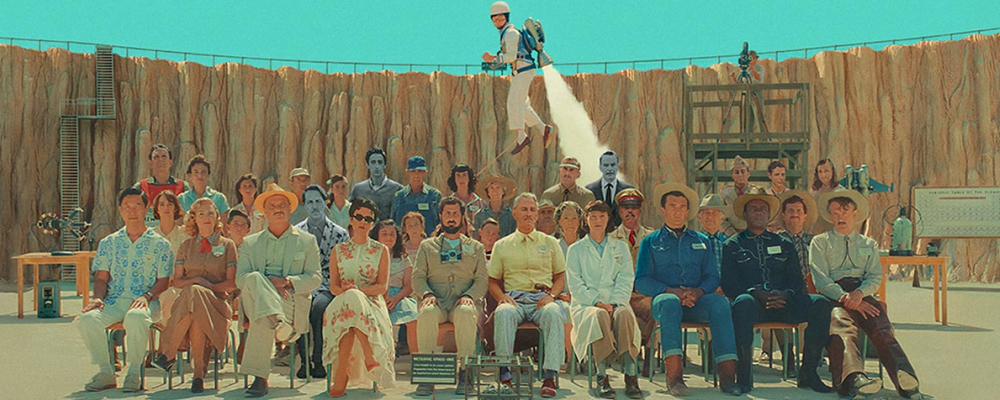Wes Anderson’s latest is a retro-futurist ’50s postcard that touches intriguingly, if perhaps too lightly, on the theme of making sense of meaninglessness.
Framed as an episode of a black-and-white anthology drama series, complete with Serling stand-in (Bryan Cranston), Asteroid City is at once about the making of a fictional play and a televised colour production of that play.
In the play, Augie Steenbeck (Jason Schwartzman) is a recently widowed war photographer who arrives at a Junior Stargazer convention in the desert with his three witchy young daughters, gifted adolescent son Woodrow (Jake Ryan), and a Tupperware of his late wife’s ashes. While Schwartzman is our ostensible lead – he also plays the actor playing Augie – this is, of course, a Wes Anderson production.
Anderson has always packed his ensemble casts with luminaries and, appropriate for one about superficially about outer space, Asteroid City might be the starriest of the bunch. Most notably, Scarlett Johansson appears as Midge Campbell, a Hollywood star seemingly based on Bette Davis and Tom Hanks as Augie’s grumpy father-in-law, Stanley.
Steve Carrell is the amiable motel owner,1 Jeffrey Wright as a well-meaning General, Tilda Swinton as a kooky scientist; in the meta- narrative, Edward Norton as a Southern playwright in the vein of Tennessee Williams, Adrien Brody as an Eli Kazan-esque director2 Most are recognisable types, rather than fully developed characters, but Anderson uses our familiarity with them as a shortcut to both comedy and empathy.
Typically underplayed, almost to the point of deadpan, they are the living component of the cartoony, Death Valley-adjacent diorama that is Asteroid City, with its midcentury style, pastel colours, and occasional alien incursion.3 Shot primarily on location in Spain during Covid, Asteroid City might feel unbearably stagey were it not for Anderson’s customary visual inventiveness; making the most of the Americana aesthetic with jet-packs and death rays and vending machines dispensing property deeds.
It’s a more limited palette, though, than last year’s The French Dispatch, without the same shading and articulation.4 Amid its metafictional considerations – what’s “real”, what isn’t, and whether that matters – Asteroid City never quite succeeds in aligning its two narratives, though both are independently entertaining.
It does, however, manage a remarkable moment of pathos in its final stretch that showcases the ability of Anderson’s peculiarly affectless style, at once heightened and understated, contrived and yet simple, to hint at profound, existential truths. Even if Asteroid City doesn’t hit the heights or plumb the depths, it doesn’t mean that it’s not a blast in its own right.
- In a role originally intended for Bill Murray, making this the first of Anderson’s films Murray hasn’t appeared in since Rushmore back in 1998.
- Side note: Brody played playwright Arthur Miller, a friend and collaborator of Kazan, in last year’s Blonde.
- SPOILER: The alien in question looks like an internet meme come to life, Slender Man by way of Salad Fingers
- Literally, in its use of all-natural light.
